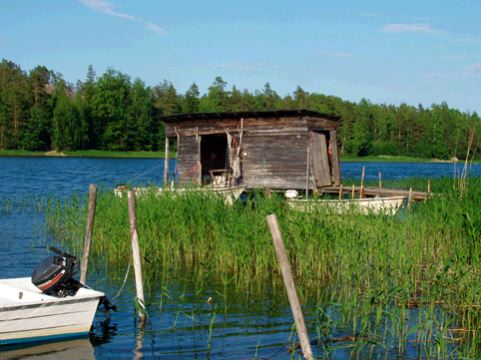

What is the meaning of these pictures, looking like holiday snaps, within the context of the Re-Institutionalize project, and what about the wooden fish?
Actually, I spent my summer holidays in Finland, on an island where my grandparents had built a little house in the days when just a few people lived there, most of them fishers. I was delighted to see the shed again (in which the fishers hung up their fishing nets to dry) and the old fisher Sigfrid. I already knew that I wanted to make the next Re-Institutionalize project on this fishing net shed, but I had no idea what to show there. At first I tried to construct an enormous fish out of reed; and then my father came back from fishing, without fish, but he brought this beautiful old piece of wood that has a shape quite similar to that of a fish! Sometimes my father doesn’t get fish, but then he tries to bring home something beautiful from an island, for example round stones, blueberries, or flowers for my mother. This time, he brought the wooden fish, and it was the perfect solution for my exhibition! I just put two stones in it to make an eye and added reed fins and … voilà! – You see, it was important for me to mark the net shed somehow, to emboss it with a gesture that would also please the fisher Sigfrid. It was my father’s idea to attach the fish above the door where usually the fishing rods were stowed. He and Sigfrid hanged the fish up; and on this occasion Sigfrid put on his special day’s hat of wooden slats, because he knew that I intended to photograph and to film the whole scene. Me myself, I was very proud of my big fish, and my mother took a photo of me when I just had finished it.
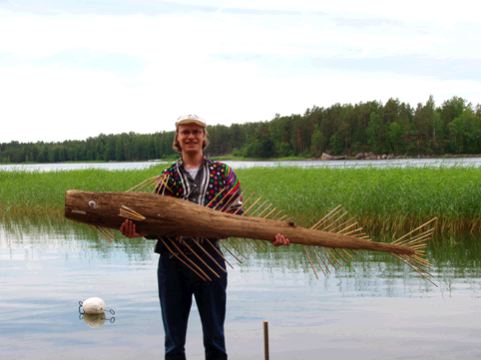
This time, too, the pictures are documenting an exhibition that has actually taken place. Yet, one has to know that the net shed and the fish… also the visitors?… were subjects of an exhibition…
For me, it was clear that the net shed was the starting point of the project this time, but I needed a gesture, a marking, something to give this picturesque wreck a particular status. It is a little bit like a museum, at some point it needs at least one art work to make claims to be a true museum – although some museums are most beautiful without any art work. So, this wooden "monsterfish" actually marked the net shed, and, at the same time, it looked as if it had been always there. The public boat dock is only fifteen meters away, and those who berthed there just couldn’t miss the fish. – Naturally, it was not a usual exhibition, and so people perceived it more like a joke; but a joke no one could say where the funny thing really lied. Perhaps it was a bad joke then – or actually no joke? I myself see the fish as "outsiderart", and all the Re-Institutionalize project could be then – as far as I’m concerned, of course - a kind of “conceptpropagandaoutsiderart”…
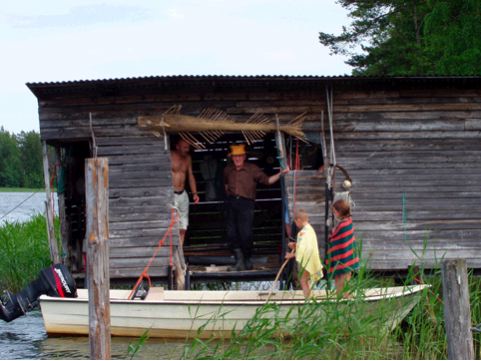
The project seems to be coordinated by terms like "site", "institution" and "art context" which are mentioned in the previous interviews. Could you say something more about it? My impression is that categories are quite important for you.
To say it quickly, this project is about the re-contextualisation of a site by an object. I use a probable art work (the old piece of wood is the classical "objet trouvé") to change a site into an art institution. This is actually the opposite of the usual process in the art world. Normally, the art world uses the prestige of an art institution to declare something to be art and to legitimize it. Yet, my supposition is that the art institution legitimizes itself in this way, above all, and that it virtually claims the position of a "meta art work": an art work without that no art work was possible. I want to turn this mechanism and see if I can’t make an art institution out of a wreck, using just a piece of wood… The "art context" isn’t something strong and stable, it is a terrain that has to be defined every time anew.
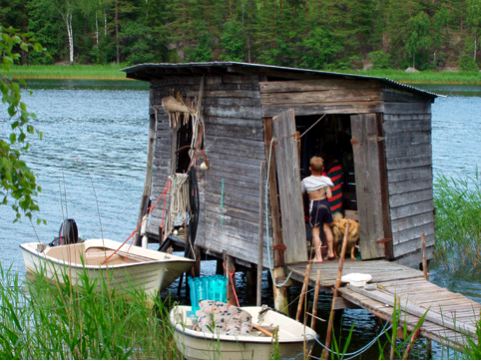
So you show an art institution; and one could see also this interview as an exhibition?
Yes; all the Re-Institutionalize project started because I got pissed of the importance of art institutions in the current art making. The already old idea that the curator actually replaces the artist has a symptomatical consequence in the idea that the institutions actually replace the art works. So there is a meta level on which curators and institutions are inventing and managing artists and art works. That means for an artist that he has to be adopted by a curator and an institution or – if he can’t find adoptive parents – that he has to become a curator himself and to invent an institution too to be able to work as an artist in public... This situation is very clear today, but the problem already existed for artists at the beginning of "Modern Art". For example, Gustave Courbet, in protest against the world exhibition’s jury in Paris 1855, curated his own show and constructed also his own institution (the "Pavillon du Réalisme").
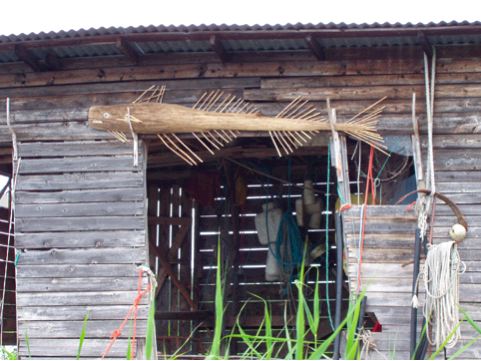
Who defines then if the photos of the fishing net shed and its guests – or they themselves – are art? Is the question of "art" important for you?
Indeed, the observer is challenged to interpret and to hold a view, but he gets only that to interpret what I give out. That means, he is always part of a scenario introduced by me. This is actually nothing new. Newspapers, marketing and film work in a similar way. Yet, I make and finance it all by myself, so I am very independent. Fortunately, I can’t control it all even so, since other people are also involved; and, mainly, because pictures always get out of control. – Naturally, the question of art is important to me, but not demanding as: "Attention, these pictures are art!" It is more about involving the observer and the reader into my scenario, by photos and text, and to get him to think about art on the occasion of a real example.

You are portrayed, too. Are these photos helpful to understand art, do you show them for this purpose? – What is the message of the pictures?
I am portrayed only on the photo that my mother took, with the fish in my arms. Just like a lot of amateur fishers who like to pose proudly with the fish they have caught. Re-Institutionalize is a project in the social space, an art project that involves places, people and situations. Therefore it is important to me that those who are busy at a site are also visible on the photos. It is, maybe, comparable to a report that makes itself its subject – not a report about a report, but a report that intends to earn some experience about itself. Insofar, the photos contribute just indirectly to the purpose of understanding art. They are part of the art project and, at the same time, they document it. I think the ideal observer is like an accomplice and should be able to become, seeing the photos, part of the project from a distance.
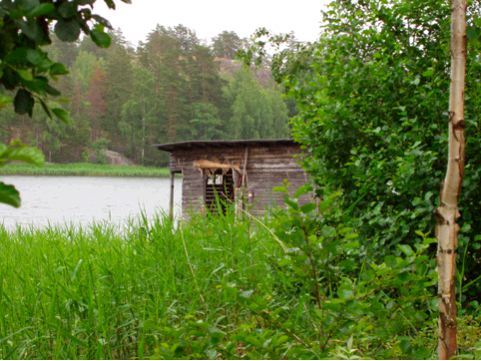
Who do you want to reach?
I always have the naïve imagination that my art can give everybody something, and, principally, I try to reach as many persons as possible. That’s also a reason why I like E-mail as a medium together with an internet-documentation. But I know that only a few people have time and interest to occupy themselves with art. And especially those who deal with art as professionals have very little time and interest to discover something new by themselves. Nevertheless, I hope that as many people as possible will open and read my E-mails and the Re Institutionalize documents as a kind of message in a bottle.
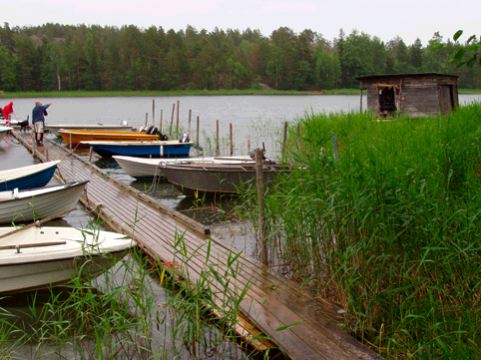
Interview: Heike Wetzig & Kristofer Paetau, August 2004
Re-Institutionalize # 04: Net shed